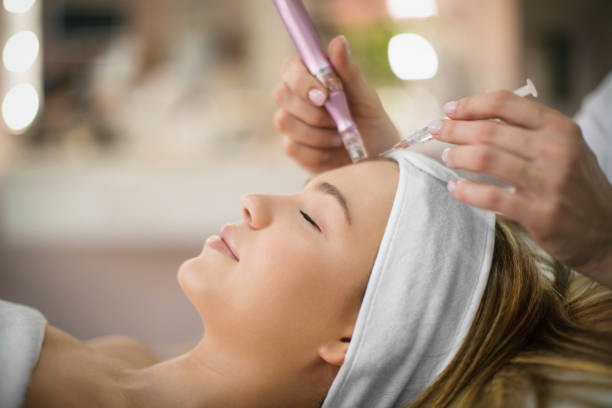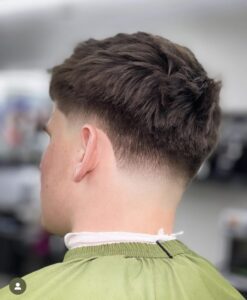When it comes to revitalizing your skin, two of the most popular non-surgical treatments available today are Derma pen microneedling and chemical peels. Both aim to improve skin tone, texture, and overall appearance—but which one is better for your skin concerns?
In this guide, we compare Derma Pen and chemical peels side by side, helping you make an informed decision based on science, skin type, and your aesthetic goals.
Understanding the Basics
What is Derma Pen?
Derma Pen is a microneedling device that uses tiny, controlled needles to create micro-injuries in the skin. These trigger the body’s natural healing process, stimulating collagen and elastin production, and enhancing skin renewal.
Key benefits:
-
Improves acne scars
-
Reduces fine lines and wrinkles
-
Tightens skin
-
Enhances product absorption
-
Safe for all skin tones
What is a Chemical Peel?
Chemical peels involve applying a solution (often containing glycolic, lactic, salicylic, or TCA acids) to the skin to exfoliate the outer layers. This process reveals fresher, brighter skin and stimulates regeneration.
Key benefits:
-
Treats sun damage and pigmentation
-
Reduces fine lines and texture
-
Controls acne and oiliness
-
Promotes brighter, even-toned skin
How They Work: The Scientific Approach
Derma Pen – Stimulating from Within
The Derma Pen promotes collagen induction therapy (CIT). By creating micro-channels, the skin responds by rebuilding with new, stronger collagen fibers, resulting in firmer, smoother skin.
This process occurs in three phases:
-
Inflammation (0–2 days)
-
Proliferation (3–7 days)
-
Remodeling (weeks to months)
Chemical Peels – Surface-Level Regeneration
Chemical peels work by breaking down dead skin cells and encouraging exfoliation. Depending on the strength (superficial, medium, or deep), peels target different skin layers. Superficial peels focus on brightening, while deeper peels address texture and pigmentation.
Best For: A Condition-by-Condition Comparison
| Skin Concern | Derma Pen | Chemical Peel |
|---|---|---|
| Acne Scars | ✅ Effective for all scar types | ⚠️ Mild improvement only with strong peels |
| Hyperpigmentation | ✅ Excellent when paired with serums | ✅ Highly effective with brightening agents |
| Fine Lines/Wrinkles | ✅ Stimulates collagen from within | ✅ Peels help, especially with regular use |
| Large Pores | ✅ Improves skin tightness and tone | ⚠️ Temporary reduction; less structural change |
| Dull Skin | ✅ Gradual radiance with repeated sessions | ✅ Instant glow post-treatment |
| Oily Skin/Acne | ⚠️ Needs cautious use on active acne | ✅ Great for controlling oil & breakouts |
Derma Pen Recovery
-
Downtime: 1–3 days of redness and mild swelling
-
Side effects: Slight flaking, tightness, sensitivity
-
Aftercare: Gentle hydration, sun protection, no makeup for 24 hours
Chemical Peel Recovery
-
Downtime: Depends on strength—1 day (light) to 7+ days (deep)
-
Side effects: Peeling, redness, sensitivity, risk of hyperpigmentation
-
Aftercare: Sunscreen, soothing moisturizers, avoid exfoliants
Skin Tone Considerations
-
Derma Pen is generally safer for darker skin types (Fitzpatrick IV–VI), as it carries minimal risk of post-inflammatory pigmentation.
-
Chemical peels, especially stronger ones, may cause pigmentation in darker complexions if not carefully selected and applied.
Treatment Frequency
-
Derma Pen: Every 4–6 weeks; a series of 3–6 sessions recommended
-
Chemical Peels: Light peels can be done monthly; medium/deep peels spaced 2–6 months apart
Cost and Customization
Both treatments can vary in cost depending on your provider and region. However, Derma Pen sessions are often customized with serums like hyaluronic acid, growth factors, or peptides for enhanced results. Chemical peels also offer customization in terms of peel type and depth.
Which Is Better?
Choose Derma Pen if:
-
You’re targeting deep acne scars or wrinkles
-
You want collagen-boosting, long-term effects
-
You have darker or sensitive skin
-
You prefer minimal downtime
Choose Chemical Peel if:
-
You want a quick glow or pigmentation fix
-
You struggle with acne, clogged pores, or oil
-
You’re treating surface-level texture or dullness
-
You prefer non-invasive, exfoliating options
Final Verdict:
Many skin experts recommend combining both treatments in a professional setting. For instance, a light peel can prep the skin before Derma Pen or enhance results afterward. When spaced correctly, the synergy between collagen stimulation and surface exfoliation yields exceptional results.
Reveal Your Best Skin at Royal Clinic Saudia
Whether you’re leaning toward Derma Pen or a custom chemical peel, Royal Clinic Saudia offers personalized skin treatments backed by science and performed under expert care. Book your consultation today and take the first step toward healthier, radiant skin.
FAQs:
Can I get both a Derma Pen and a chemical peel?
Yes, but not on the same day. Most clinics recommend spacing them out by 2–3 weeks for optimal skin healing.
Which one has faster results?
Chemical peels offer immediate brightness, while Derma Pen shows progressive improvement over weeks as collagen builds.
Is one safer than the other?
Both are safe when performed by trained professionals. However, Derma Pen is generally safer for darker skin tones.
Can I do these treatments at home?
Only light peels or Derma Pen devices with minimal depth are safe at home. For best results, professional sessions are advised.









